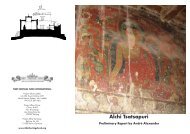Beijing Hutong Conservation Plan - Tibet Heritage Fund
Beijing Hutong Conservation Plan - Tibet Heritage Fund
Beijing Hutong Conservation Plan - Tibet Heritage Fund
Create successful ePaper yourself
Turn your PDF publications into a flip-book with our unique Google optimized e-Paper software.
) Building condition<br />
b-1. Condition<br />
The strict traditional space delineation of the <strong>Beijing</strong> courtyard house started to become more flexible after the fall of<br />
the Qing dynasty. Rules proscribing designs and sizes in relation to the hierarchies of imperial society were no longer in<br />
effect. During the social reforms of the 1950s and the Cultural Revolution, courtyards were sub-divided, and in order<br />
to accommodate thousands of homeless people after the 1976 Tangshan earthquake, further sub-division were made,<br />
leading to a sprouting of flimsy extension buildings that fill up most of the courtyards of publicly-owned housing.<br />
Residents have also often modified or reconstructed the original buildings. However, during our survey, we found it<br />
was possible in many case to determine the historic structure.<br />
Courtyard houses converted into public housing have been most drastically modified, but some buildings in the survey<br />
area marked as cultural relic sites have preserved their original structure reasonably well, even if used as housing.<br />
Grading the three areas, in Chaodou we found the largest number of intact structures, in Gulou most courtyards have<br />
been filled with extensions, and in Yandai, the street fronts with their old carved windows are preserved, but inside the<br />
original structures have been lost in almost every case.<br />
b-1-1. Common structural problems<br />
The most common building problems that we found were roof leaks, damages to the timber structure caused<br />
by insects and rot, and ground humidity creeping up the walls. Most problems were caused by lack of<br />
maintenance. Poorly-lit rooms with poor ventilation increase the problems caused by humidity, and<br />
rehabilitation must include mechanisms to correct these faults. In regards to rehabilitation, several of the sites<br />
require extensive repairs of the roofs, but after an initial investment to correct decade-old damages, regular<br />
maintenance will be not very costly if done on an annual basis. We found rehabilitation preferable to<br />
reconstruction.<br />
Courtyard open space isocupied by extention buildings<br />
Timber structure damaged by roofleake, in many cases<br />
structure problems caused by water and humidity<br />
35




